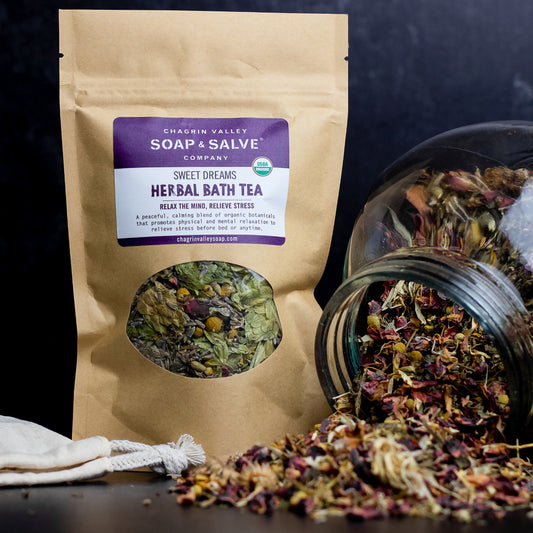How to Use Herbs for a Postpartum Sitz Bath
During the first weeks after giving birth, the body begins to heal and adjust. This period of time is called the postpartum or postnatal period. The body goes through many changes during recovery. These changes are different for every woman.
The body’s ability to birth a tiny little person is absolutely amazing. However, the vaginal delivery of that little "bundle of joy" often results in not so joyful symptoms in the perineal area.

What Is A Postpartum Sitz Bath
The word "sitz" is derived from the German verb sitzen, meaning "to sit". This is the perfect term considering that the purpose of a sitz bath is to sit in water.
Unlike a regular bath, where your whole body is submerged in water, a sitz bath targets the perineum (the thin layer of skin between your vaginal opening and anus) and the tender areas that surround it. Basically it is a very shallow bath filled with warm water and soothing ingredients.
While they can be used for various other reasons, sitz baths are especially helpful after a vaginal birth to keep the perineum clean and soothe symptoms such as swelling, itching, discomfort, irritation, minor pain, hemorrhoids, stitches, bruising, or tearing.
Perineal skin can also be very sensitive to touching. Wiping with a piece of toilet paper can feel like sandpaper on that hypersensitive skin for a few weeks after delivery. However, it is important to keep the area clean to help the healing process and decrease the risk of further irritation or infection. A warm sitz bath can gently clean the area without the need for scrubbing which can irritate this super sensitive skin.
An herbal bath tea can be used in a regular bath as well, but many medical professionals suggest waiting 2 to 4 weeks for your first full postpartum bath to ensure the cervix has completely closed. **Be sure to ask the advice of your doctor or midwife as to when full bathing is recommended.
How To Prepare a Sitz Bath
First of all, be sure to talk with your midwife or doctor before using a sitz bath.
Remember a sitz bath is a warm, very shallow bath designed to bathe your perineal area. You can give yourself a sitz bath in your bathtub or you can buy a reusable plastic sitz bath kit that fits inside your toilet bowl.
When setting up your sitz bath you can choose two different water temperatures based on your healing needs or personal preference.
 Warm sitz baths are great for healing, can help ease discomfort, and soothe delicate skin. Soaking this area in warm water relaxes the muscles which helps increase blood flow to promote healing and ease pain, itching and irritation.
Warm sitz baths are great for healing, can help ease discomfort, and soothe delicate skin. Soaking this area in warm water relaxes the muscles which helps increase blood flow to promote healing and ease pain, itching and irritation.
However, some studies suggest cool sitz baths work well to relieve swelling. You can ask your health professional which they prefer and why, but be sure the bath feels soothing to you!
Cleanliness is important when using a sitz bath of any type. Make sure the tub or sitz basin is clean in order to decrease the chance of infection. This is not a time for soaping up in the tub.
If you are purchasing a sitz bath tub, follow the directions to use it properly.
Prepare the herbs (see below).
For a Tub Bath Sitz Bath:
- Fill the bathtub with about 4 inches (10 cm) of warm or cool water (your preference) water. Depending on your size and shape remember you want only enough water to cover your perineal area. You are not submerging yourself in the tub.
- Add the prepared herbal tea or tea bag.
- You may also add epsom salt to the bath. It is not a necessary addition. Some believe it helps reduces pain and swelling, others may find it irritating. Add no more than 1/4 cup of epsom salt to your tub or about 1 tablespoon for a small sitz tub.
- Carefully lower yourself into the bath until your bottom is submerged.
- To best target the perineum, soak with your knees bent.
- Soak for 10-20 minutes or as directed by your healthcare professional.
- When you are finished, very gently pat the perineal area dry with a clean cotton towel. Any rubbing or hard pressure can cause irritation or harm to the skin.
You can repeat your sitz bath a few times during the day. Again seek advice from your healthcare professional.
Although a sitz bath is a low risk procedure, if you notice any increased tenderness, redness, or pain after the bath, discontinue use and see your midwife or doctor to provide medical advice.
TIP: Since you will be soaking in your sitz bath for around 20 minutes, carve out some time for yourself.
How to Use Herbs in a Postpartum Sitz Bath
There are many different herbs that are safe, soothing and helpful for tissue healing and pain reduction in the postpartum period. Some suggestions include:
- Calendula flowers
- Chamomile flowers
- Chickweed
- Lavender flowers
- Lemon Balm
- Plantain leaves
- Marsh Mallow root
- Rosemary leaves
- Yarrow flowers
Some also suggest adding oatmeal, epsom salt, or sea salt. While oatmeal is always a soothing addition to any bath, some find epsom salt or sea salt to be irritating.
Obviously, your postpartum sitz bath does not need to contain all of these ingredients, but some combination of even a few of them is fine.
There is no exact recipe and you don’t have to be precise when mixing up an herbal bath tea.
Of course, we suggest using our Baby Me! Herbal Bath Tea or Soothe My Skin Herbal Bath Tea. They both contain soothing oatmeal and botanicals. The Soothe My Skin also contains pure Himalayan Pink Salt. Although some find the salty water soothing, others may feel irritation.
 Method 1: For a stronger herbal sitz bath, brew some herbal tea in a pot, and then add the steeped tea to the bathwater or sitz tub.
Method 1: For a stronger herbal sitz bath, brew some herbal tea in a pot, and then add the steeped tea to the bathwater or sitz tub.
- Bring 2 quarts of water to a boil.
- Add 1/4 cup of herbs to boiling water. You can add loose tea or place the herbs in a tied up piece of cloth, cheesecloth, muslin bag, or even a clean sock.
- Keep the pot covered so the natural essential oils from the herbs do not evaporate.
- Gently simmer for up to ten minutes, or turn off the heat and let the herbs steep for a few hours.
- Strain the herbs (if required), and then add the tea to your bath water.
Time saving tip: Double or triple the recipe and save the extra tea for your next sitz baths. Keep it refrigerated and then warm before use if desired.
Method 2: If you don’t have the time to brew a tea, place the dried herbs in a muslin bag and add it straight to your bath water. Allow the bag to sit for a few minutes and then squeeze the bag to release more of the botanical essence.
If you are using the reusable muslin bag supplied with our bath tea, toss the contents of the tea bag into the garden or compost. Rinse the bag and allow it to dry.
No Time for Sitz Bath
While you can use the herbal tea in your bathtub or a sitz bath, a peri bottle or bath tea compress can also be helpful.
To use the teas as an herbal compress: Soak a clean cotton washcloth in the herbal tea and apply it either warm or cool to the perineum as needed to reduce tenderness, irritation, or swelling.
To use a peri bottle: Short for perineum bottle, a peri bottle is essentially a portable bidet. It is a plastic squeeze bottle that allows you to gently clean the perineal area. You can purchase a peri bottle from any pharmacy or use a CLEAN squeeze bottle that you already have.
Fill the bottle with your prepared tea. While sitting on the toilet, point the opened tip towards the perineal region. Squeeze the warm or room temperature tea over the area. Once you are done, dry the area with toilet paper by gently dabbing. Avoid "wiping," which can be irritating.
The tea will help cleanse the area and reduce the stinging feeling that is associated with urination after birth. As a matter of fact many say that the best time to use the peri bottle is while peeing. How? Start squirting a stream of tea, begin peeing, then continue the stream of tea. The herbal tea (or even warm water) dilutes the urine which eases stinging.
What About After a C-Section?
The many benefits of a sitz bath, peri bottle or compress absolutely extend to people whose babies are born by C-section. While the perineal area may not be as sore after a C-section as with a vaginal delivery, there will still be vaginal discharge to rinse away. Plus, if you were in labor or did any pushing before having a C-section, you may have swelling, discomfort or inflammation in the perineal area.
A peri bottle can also be very helpful when it is painful or difficult to bend over to wipe because of the incision.
The Bottom Line (sorry)
A vaginal birth causes stress to the already sensitive perineal area. Swelling, itching, discomfort, irritation, pain, hemorrhoids, stitches, bruising, or tearing can really be a pain in butt (sorry again!).
A few simple solutions like an herbal sitz bath, an herbal perineal compress, or herbal peri bottle spritz, can help soothe the irritated area and bring relief.
After having a baby, it is important to pay attention to your body. If you are using a postpartum sitz bath and it does not seem to be helping, make sure to talk with your midwife or doctor.
A sitz bath can also be helpful to anyone, men and women, with a perineal injury or irritation from surgery, hemorrhoids, Bartholin cysts, anal fissures, genital itchiness and more. Always seek advice from your healthcare provider.


